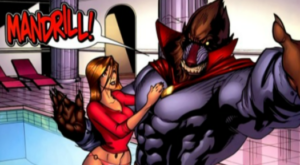Over the decades, Marvel Comics has introduced a bevy of villains into its universe that have garnered controversy over the years due to issue faces or sensitive topics they represent. This ignites debates about representation, storytelling ethics, and the obligations of those who create. Here are five of the most controversial Marvel evil doers:
Mandrill (Jerome Beechman) 
Mandrill, who first appeared in the 1970s, is a character born out of controversy. Mandrill’s white parents are combined with black fur and ape-like silhouettes resulting from exposure to radiation, fitting crude, insulting racial stereotypes. His prowess makes the problem worse: he gives off pheromones that enable him to beguile women, who then become members of his cult, the “Femizons.” This was a completely blinkered stance, and in fact the combination of racist imagery and misogynistic themes that has rendered Mandrill a highly problematic figure within the Marvel pantheon.
Ultimate Blob
In Ultimate Marvel, an alternate version of the classic Blob, was shown as a cannibal, having eaten the Wasp. This grim depiction was condemned for its excessive violence and alleged misogyny, as it seemed to exploit the degradation of a female figure for the sake of provocation. It led to conversations about the ethics of such choices in storytelling.
Scarlet Witch
These characters, like Scarlet Witch, who is often depicted as a hero, have had aspects of their stories used to paint them in a controversial light. Her presence in real world plots – narratives such as “House of M,” in which she rewrote reality and depowered most every mutant in the world to a far greater degree than even normal human society – is one of the reasons for much debate about whether she’s a villain herself and how mental health is represented in comics.
Captain Hydra
Revealing Steve Rogers also as a Hydra sleeper agent with their 2016 storyline shocked fans and came with backlash. Considering Captain America’s roots as a stance against fascism, many viewed this narrative twist as a betrayal to the character’s values, and the controversy grew enough to make headlines.
Red Skull
But Nazis can be troubled characters for comic book companies to handle, and Red Skull is one of most troubling of the bunch because of the sensitive nature of his beliefs and actions. His character reminds him of real-world horrors, and his performance has opened up conversations about how such figures are portrayed in entertainment.
These characters highlight moments when Marvel’s storytelling intersected with real-world issues, leading to debates about representation and the impact of media portrayals.
More: Comic




